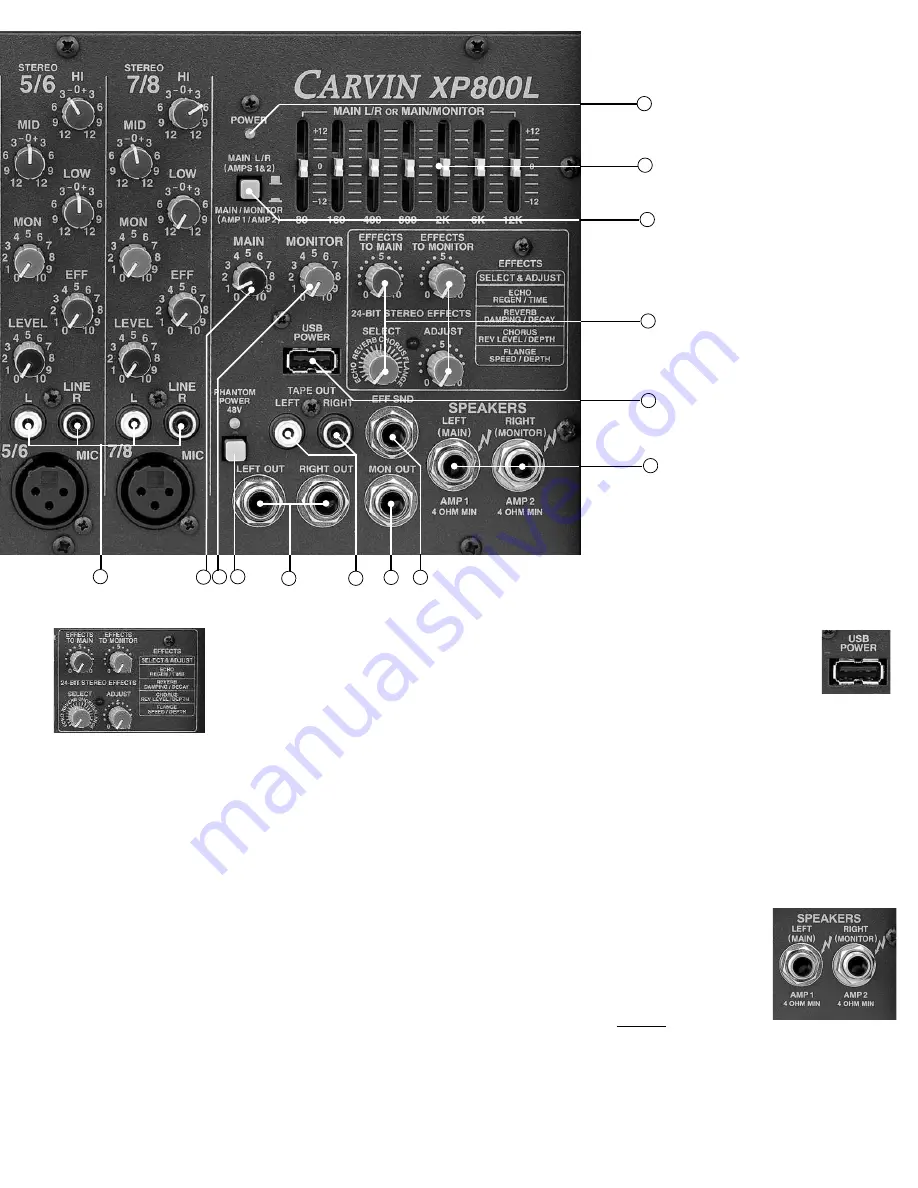
16. DSP EFFECTS PROCESSOR
A 24-Bit processor provides a host of great sounding
effects including Echo, Reverb, Chorus, and Flange.
The channel
EFF
send control delivers the signals to
the processor. Note: Reduce these levels if the red
PEAK LED is flashing near the main processor con-
trols.
Turn up the EFFECTS TO MAIN control to add effects
to the MAIN LEFT and RIGHT outputs.
Turn up the EFFECTS TO MONITOR control to add
effects to the MONITOR outputs.
Adjust the SELECT and the PARAMETER controls to
get the desired effect. Note: An audible noise will be
heard while adjusting the effects.
A) ECHO: Turn SELECT for the amount of regenera-
tion (repeats). Now turn the PARAMETER control for
a shorter or longer delay time between the original sig-
nal and the echo.
B) REVERB: Turn SELECT for the amount of pres-
ence (high frequencies) in the reverb. Now turn the
PARAMETER control to change the decay time of the
reverb.
C) CHORUS: Turn SELECT for the amount of reverb
with your chorus. Now turn the PARAMETER control
to change the chorus depth.
D) FLANGE: Turn SELECT for the speed of your
flange (phasing effect). Now turn the PARAMETER
control to change the flange depth.
17. EFF SEND JACK
The EFF SEND jack can send a signal to an external
processor. This is the same signal sent to the internal
effects processor.
Effect returns can be connected to any input channel.
Make sure the EFF control for the return channel is
set to “O” or feedback will occur.
18. POWER LED
The blue POWER LED indicates the mixer is pow-
ered ON.
19. MAIN/MONITOR SWITCH - AMP ASSIGN
With the switch “IN” ,
AMP 1
is for MAIN (mono), and
AMP 2
is for MONITOR.
With the switch “OUT”,
AMP1
and
AMP2
are in
stereo for the MAIN LEFT and RIGHT speakers.
The front MON OUT jack is unchanged by the switch
setting and can be used for external power amps or
in-ear monitor systems.
20. STEREO GRAPHIC EQ
When the EQ sliders are in their center position, they
do not affect the audio signal. When EQ sliders are
raised or lowered from this position, they boost or cut
a narrow frequency band.
For tone enhancement you may want to raise the
80Hz and 160Hz sliders (for deeper bass) and the
6kHz and 12kHz sliders (for crisper highs) while reduc-
ing the 400Hz, 800Hz and 2kHz sliders in a moder-
ate “curve”.
To help prevent feedback, microphones should be
placed behind the main speakers.
To reduce feedback in the low frequency range, try
lowering one of the 80Hz or 160Hz sliders. High fre-
quency feedback is usually reduced by lowering the
2kHz or 6kHz sliders.
21. USB POWER PORT
The USB POWER PORT allows
charging of an iPod™/ MP3 player,
or to power accessories such as LED
lighting. Connect audio outputs from
devices to the
LINE L-R
inputs on
channels 5/6 or 7/8.
22. 48V PHANTOM POWER SWITCH / LED
The
48V
PHANTOM POWER switch turns on the
microphone phantom power in the channel XLR
jacks. This power is used for supplying a high volt-
age to condenser microphones. The
LED
indicates
the phantom power is turned on. The phantom power
will not damage conventional dynamic microphones.
Note: Make sure the phantom power is switched off
before connecting or disconnecting microphones to
avoid a “pop”.
23. SPEAKER OUTPUTS
Each amp has a 4ohms MIN-
IMUM IMPEDANCE
(Maximum
TWO
8ohms
speakers, OR
ONE
4ohms
speaker
per AMP output jack).
MAKE ALL CONNECTIONS
BEFORE TURNING THE
MIXER ON.
REAR PANEL FEATURES:
POWER SWITCH AND AC CONNECTOR
The rear panel contains the POWER SWITCH and AC
power cable connection.
11
15
3
19
21
20
22
16
17
18
23
14
12
13




